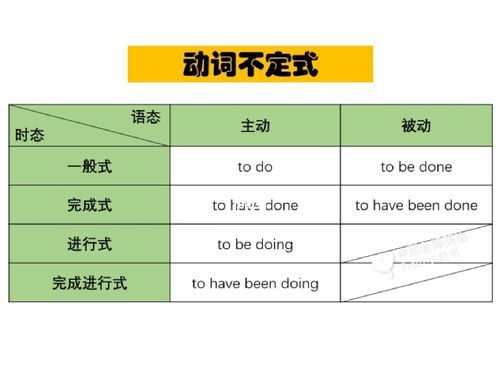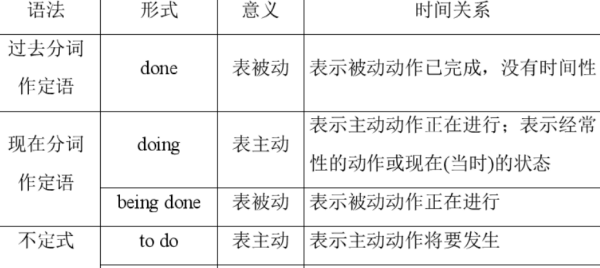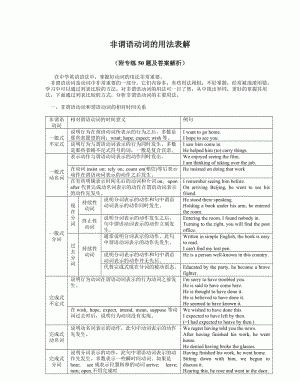本文目录
怎么识别非谓语动词在句子中充当什么成分举例
非谓语动词包括动名词,动词不定式和分词.
【动词不定式】可在句子中充当:主语、宾语、表语、定语、状语、补足语 (宾补和主补)
【动名词】刻在句子中充当:主语、宾语、表语、定语 (具有名词特性)
【分词】可在句子中充当:定语、表语、状语、补足语

非谓语动词作定语简单的例句
非谓语动词作定语解题的关键在于:
(1)看非谓语动词与其逻辑主语(即被修饰词)之间是主谓还是动宾关系。
(2)看非谓语动作与谓语动作的时间关系,两者是同时发生还是非谓语动作已经完成或尚未发生。
如果非谓语动词与其逻辑主语之间是主动关系:
如果非谓语动词所表示的动作正在进行,则用doing。
如果非谓语动词所表示的动作尚未发生,则用to do。
如果非谓语动词与其逻辑主语之间是动宾关系:
非谓语动词所表示的动作正在进行,则用beingdone。
非谓语动词所表示的动作已经完成则用done。
非谓语动词所表示的动作尚未发生则用to be done。

常见的形式:
非谓语作定语是比较简单的点,常见的考法是在名词后作定语。常见的形式为现在分词、过去分词、不定式。需要关注被修饰词与该词之间的逻辑关系。
单个分词作定语,放到被修饰词前;分词短语作定语,放到被修饰词后。
如何判断非谓语动词在句子中做定语还是状语举例
首先非谓语动词形式包括不定式,动名词,和分词,分词又包括现在分词和过去分词。
做定语和状语的区别是,状语时修饰动词,形容词,副词,定语修饰名词或代词,所以在句子中,看被修饰词是什么词性

非谓语动词怎么判断逻辑主语
(一)动词不定式:(to)+do,具有名词、形容词、副词的特征。
否定式:not + (to) do
(1)一般式:不定式的一般式所表示的动作与谓语动词动作同时发生或发生在谓语动词动作之后,
例如:
I'm glad to meet you.
He seems to know a lot.
We plan to pay a visit.
He wants to be an artist.
The patient asked to be operated on at once.
The teacher ordered the work to be done.
(2)进行式:不定式的进行式所表示的动作与谓语动词动作同时发生,例如:
The boy pretended to be working hard.
He seems to be reading in his room.
(3)完成式:不定式的完成式表示的动作发生在谓语动词动作之前,例如:
I regretted to have told a lie.
I happened to have seen the film.
He is pleased to have met his friend.
2.不定式的句法功能:
(1)作主语:
To finish the work in ten minutes is very hard.
To lose your heart means failure.
动词不定式短语作主语时,常用it作形式主语,真正的主语不定式置于句后,例如上面两句可用如下形式:
It is very hard to finish the work in ten minutes.
It means failure to lose your heart.
常用句式有:1、It+be+名词+to do。2、It takes sb.+some time+to do。3、It+be+形容词+of sb +to do。4、It+be+形容词+for sb.+to do。常用careless,,clever,good,foolish,honest,kind,lazy,nice,right,silly,stupid,wise,等表示赞扬或批评的形容词,不定式前的sb.可作其逻辑主语。
(2)作表语:
Her job is to clean the hall.
He appears to have caught a cold.
(3)作宾语:
常与不定式做宾语连用的动词有:want, hope, wish, offer, fail, plan, learn, pretend, refuse, manage, help, agree, promise, prefer, 如果不定式(宾语)后面有宾语补足语,则用it作形式宾语,真正的宾语(不定式)后置,放在宾语补足语后面,例如:
Marx found it important to study the situation in Russia.
动词不定式也可充当介词宾语,如:
I have no choice but to stay here.
He did nothing last Sunday but repair his bike.
动词不定式前有时可与疑问词连用,如:
He gave us some advice on how to learn English.
(4)作宾语补足语:
在复合宾语中,动词不定式可充当宾语补足语,如下动词常跟这种复合宾语:want, wish, ask, tell, order, beg, permit, help, advise, persuade, allow, prepare, cause, force, call on, wait for, invite.
此外,介词有时也与这种复合宾语连用,如:
With a lot of work to do, he didn't go to the cinema.
有些动词如make, let, see, watch, hear, feel, have等与不带有to的不定式连用,但改为被动语态时,不定式要加to, 如:
I saw him cross the road.
He was seen to cross the road.
(5)作定语:
动词不定式作定语,放在所修饰的名词或代词后。与所修饰名词有如下关系:
①动宾关系:
I have a meeting to attend.
注意:不定式为不及物动词时,所修饰的名词如果是地点、工具等,应有必要的介词,如:
He found a good house to live in.
The child has nothing to worry about.
What did you open it with?
如果不定式修饰time, place, way,可以省略介词:
He has no place to live.
This is the best way to work out this problem.
如果不定式所修饰名词是不定式动作承受者,不定式可用主动式也可用被动式:
Have you got anything to send?
Have you got anything to be sent?
②说明所修饰名词的内容:
We have made a plan to finish the work.
③被修饰名词是不定式逻辑主语:
He is the first to get here.
(6)作状语:
①表目的:
He worked day and night to get the money.
She sold her hair to buy the watch chain.
注意不定式放句首时,逻辑主语与句子主语要一致:
wrong:To save money, every means has been tried.
right:To save money, he has tried every means.
wrong:To learn English well, a dictionary is needed.
right:To learn English well, he needs a dictionary.
②表结果:
He arrived late to find the train gone.
常用only放在不定式前表示强调:
I visited him only to find him out.
③表原因:
They were very sad to hear the news.
④表程度:
It's too dark for us to see anything.
The question is simple for him to answer.
(7)作独立成分:
To tell you the truth, I don't like the way he talked.
(8)不定式的省略:保留to省略do动词。
If you don't want to do it, you don't need to.
(9)不定式的并列:第二个不定式可省略to。
He wished to study medicine and become a doctor.
(二)动名词:
动名词既具有动词的一些特征,又具有名词的句法功能。
1.动名词的形式: Ving
否定式:not + 动名词
(1)一般式:
Seeing is believing. 眼见为实。
(2)被动式:
He came to the party without being invited.他未被邀请就来到了晚会。
(3)完成式:
We remembered having seen the film. 我们记得看过这部电影。
(4)完成被动式:
He forgot having been taken to Guangzhou when he was five years old.
他忘记五岁时曾被带到广州去过。
(5)否定式:not + 动名词
I regret not following his advice. 我后悔没听他的劝告。
(6)复合结构:物主代词(或名词所有格)+ 动名词
He suggested our trying it once again. 他建议我们再试一次。
His not knowing English troubled him a lot.
他不懂英语给他带来许多麻烦。
2.动名词的句法功能:
(1)作主语:
Reading aloud is very helpful. 朗读是很有好处的。
Collecting stamps is interesting. 集邮很有趣。
当动名词短语作主语时常用it作形式主语。
It's no use quarrelling.争吵是没用的。
(2)作表语:
In the ant city, the queen's job is laying eggs.
在蚂蚁王国,蚁后的工作是产卵。
(3)作宾语:
They haven't finished building the dam. 他们还没有建好大坝。
We have to prevent the air from being polluted.
我们必须阻止空气被污染。

以上就是关于怎么看非谓语动词修饰谁 ,怎么识别非谓语动词在句子中充当什么成分举例的全部内容,以及怎么看非谓语动词修饰谁 的相关内容,希望能够帮到您。

